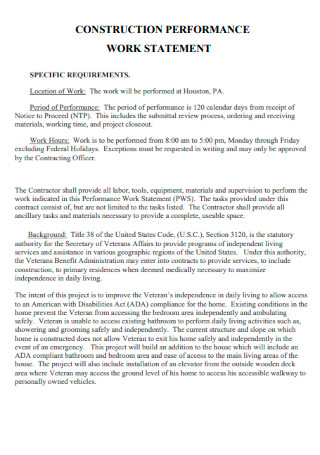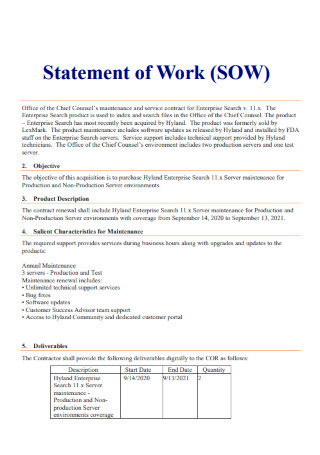20+ SAMPLE Work Statement
-

Statement of Work Contract Activities
download now -

Statement of Work for Multimedia Production
download now -

Decent Work Statement
download now -

Daily Work done Statement
download now -

Fair Work Statement
download now -

Independent Contractor Certified Work Statement
download now -

Master Service Agreements Statement of Work
download now -

Statement of Work Concrete Repair
download now -

Draft Statement of Work
download now -

Description & Specification Statement of Work
download now -

Meaningful Work Statement
download now -

Construction Performance Work Statement
download now -

Sample Statement of Work
download now -

Social Work Personal Statement
download now -

Basic Statement of Work
download now -

Special Audit Statement of Work
download now -

Healthcare Financing Statement of Work
download now -

Statement of Work Construction Service
download now -

Editable Statement of Work
download now -

Statement of Work For Technology Services
download now -

Printable Statement of Work
download now
What Is a Work Statement?
A work statement is a business document and a working agreement between two parties to align the objectives of a particular project. The statement of work, or work statement, aids the parties in developing the scope of work for the project. The document drafting starts before the implementation of a project. It also enables the parties to define the essential elements of the project, including the project objectives for detailed and daily tasks, budget plans, project schedules, etc. Work statements are prevalent when there is a collaboration between a company and a third party for external projects while serving as a contract between the involved parties. For example, a company develops a work statement when collaborating with a design firm for a specific project or when dealing with building contractors when working on large-scale construction projects. Companies must develop intricate, complex, and well-developed statements of work when dealing with government agencies and contracts that are essential additions to requests for proposals or requests for quotations. Work statements are also relevant during internal projects, especially when different departments collaborate on a program. A project manager or leader, contractors, collaborators, and every individual working on the collaboration must receive the statement of work.
According to the article from McKinsey and the McKinsey Global Survey, there is about 80 percent of businesses utilize various social collaboration tools to enhance different business operations and processes within and outside the workplace.
Components of a Work Statement
Statements of work vary depending on the industry a business belongs to, and many successful and effective work statements follow specific guidelines. Ensure that the statement incorporates precise language that shows relevance to the field of business and industry to avoid the occurrence of misinterpretations, confusion, and misunderstandings regarding the terms and conditions. Despite work statements being detail-oriented documents, it is essentially a document that demonstrates the context and general description of the work and references the supplementary documents that are particular to individual tasks in the document. As such, a work statement must include essential information for it to function as necessary. The section below covers the components of a good work statement that a business uses.
How To Effectively Construct a Work Statment for a Business Project
Writing an effective and good work statement requires time and experience. More often than not, the statement comes with the challenge of not knowing how to devise a plan, where to start, and how to visualize the outputs and deliverables at the end of the project. The work statement also serves as leverage for a scope of work statement, especially for external and collaborative projects. Using a detailed, accurate, and comprehensive statement guarantees that the teams are on the same page. Without a clear work statement, it paves the way for misunderstandings, conflicts, and miscommunications. The section below provides a guide to writing an effective work statement.
-
1. Introduce the Project and Set Its Vision
Always begin the work statement with an introduction that presents the names of key stakeholders of the project, including clients, agencies, and third-party stakeholders. Briefly define the project and the process towards project completion. It is also advisable to define the project vision to create suitable goals and achievable expectations.
-
2. Set the Project Requirements
Identify the principal foundational requirements for the project. To do this, refer to the mission statement and determine the problem to produce an aligned solution. Make sure there is an understanding between all the involved parties, and create a requirement specification list. The list serves as the foundation for the actual tasks and processes later on in the project.
-
3. Define the Project Scope and Set a Project Deadline
After presenting the vision and project requirements, the next step is to provide a project scope. Define the tasks and activities that are within and outside the scope of the project to prevent scope creep during the implementation of the project. These vital points define the project and serve as the foundation for the entire project moving forward. The purpose of the scope is to align the goals and expectations between the involved parties. It is also critical to set the start and end dates of the project. Task time estimations, available human resources, and total costs of a project are difficult to estimate but are necessary for tracking progress.
-
4. Allocate the Essential Resources
Having enough and the right resources are key to any successful project. It involves the roles, skills, and available capacity. Make sure there is a thorough assessment of the types of resources to ensure deliverables are available at the end of the project. Utilizing the team to its full potential is a driving factor for many clients to get the company for the next project. Utilizing proper capacity management guarantees the right people are available.
-
5. Create a Work Schedule and Identify Payment Terms
The next step is to set up a work schedule or a productivity timeline. Make sure to discuss the milestones and possible timeline with the client while creating the work statement to prevent the chances of scope creep, setting up all the tasks and activities within the set parameters. The timeline allows the organization to keep track of milestones throughout the project. Similar to other agreements, the work statement must indicate the terms of payment, the compensation methods, and due dates.
-
6. Accept and Sign the Agreement after Incorporating Special Requirements
Make sure to indicate additional requirements in the work statement, including security measures. Upon completing each step above, with the parties reading and understanding the contents of the work statement, the final step is to accept and sign the document.
FAQs
What makes a good work statement?
A good work statement provides essential information about a proposed project to guarantee that involved parties are on the same page when it comes to the processes, deliverables, tasks, activities, and payment terms.
How do you write a statement?
When writing a statement, there are steps that you have to remember:
- Identify the primary goal or objective of the statement
- Prepare a general introduction
- Develop a detailed body
- Finish with a strong conclusion
- Proofread the statement and revise as necessary
When to use a statement of work?
A team or an organization creates a statement of work as a guide or roadmap of the project plan to make it easier to execute.
Writing a work statement is essential before starting a project to ensure that there is clear instruction and process when individuals work on particular tasks and activities. Make sure that all essential detail is in the statement of work to lessen the occurrence of misunderstandings, disputes, and unclear instructions. The statement ensures that the scope of work that individuals perform is well within the agreement between the involved parties. Construct a work statement for your next project by downloading from the 20+ Sample Work Statement in PDF when you visit Sample.net.
